Same Experts. New Name.
SeQuel Response and FM Engage are now Franklin Madison Direct. While our name has changed, everything else remains the same: our people, our process, and our passion for driving measurable results through direct marketing.

Blog
In the last several years, AI tools have transformed the marketing and creative industries. What once felt like experimental technology has become embedded in everyday workflows, from brainstorms to campaign development.
Since its debut in late 2022—and the release of ChatGPT-4 in March 2023—ChatGPT has become the poster child for this marketing shift. This tool offers marketers a fast way to generate convincing, human-like copy.
“But fast and cost-effective doesn’t always equal success. Clients may not always be able to articulate their objectives and what resonates with them,” shares FM Direct’s Creative Director Tari Johnson shares. “Conversations to pick up on intonation and non-verbal cues are important in executing a customized, targeted, successful piece that they feel good about. Direct mail is a physical experience that makes examination of the topic important.”
While tools like ChatGPT continue to evolve, so does the conversation. We’ve gone from asking, “What can it do?” to “What should it do?”
We get it, direct response marketing campaigns are time-consuming and expensive. Some marketing teams use ChatGPT as a quick alternative to sitting down and writing copy for display ads, social media content, direct mail pieces, and other marketing materials. But is the time saved really worth it?
At Franklin Madison Direct, we’re confident that many parts of marketing still need a human touch. Direct response copywriting is at the top of that list. Creating successful direct response copy is not just about writing words—it’s about writing words that enhance the design and convert.
But don’t just take our word for it; take our results. To prove the value of human creative development, we tested ChatGPT and direct response copywriting with an 8.5 x 5.5 direct mail postcard.
Here is our process from start to finish:
To kick off our ChatGPT experiment, we selected a brand known for its captivating creative: an online wine distributor positioned as a high-end alternative to big-box retailers. For this client, luxury is everything. Their identity relies on chic language and striking visuals that evoke indulgence, sophistication, and an elevated experience.
At FM Direct, all of our direct mail campaigns include a client brief with specific requirements and expectations for the mail piece. We started this experiment by sharing the brief with ChatGPT. We then prompted it to write copy for the direct mail postcard.
We anticipated our first engagement to be haphazard since this tool requires highly-specific prompts and language to provide you with what you need.
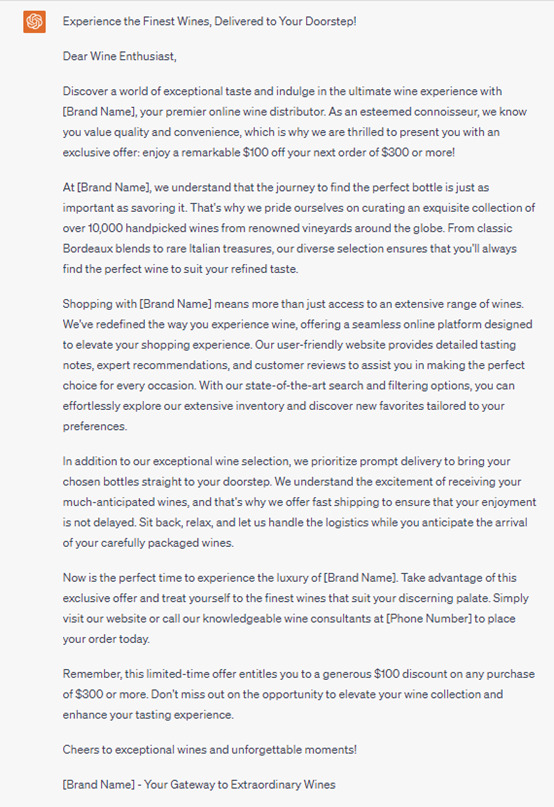
As you can see, this prompt produced a lengthy, letter-like text. Our attention spans are only shrinking, so it’s important to be precise with your direct mail copy. This is not what the client is looking for, so we told ChatGPT to narrow down its copy for postcard specs.

Although ChatGPT completed the prompt, it is hard to determine the text placement. We also cannot differentiate headers from the body copy. Next, we asked the tool to specify this information.
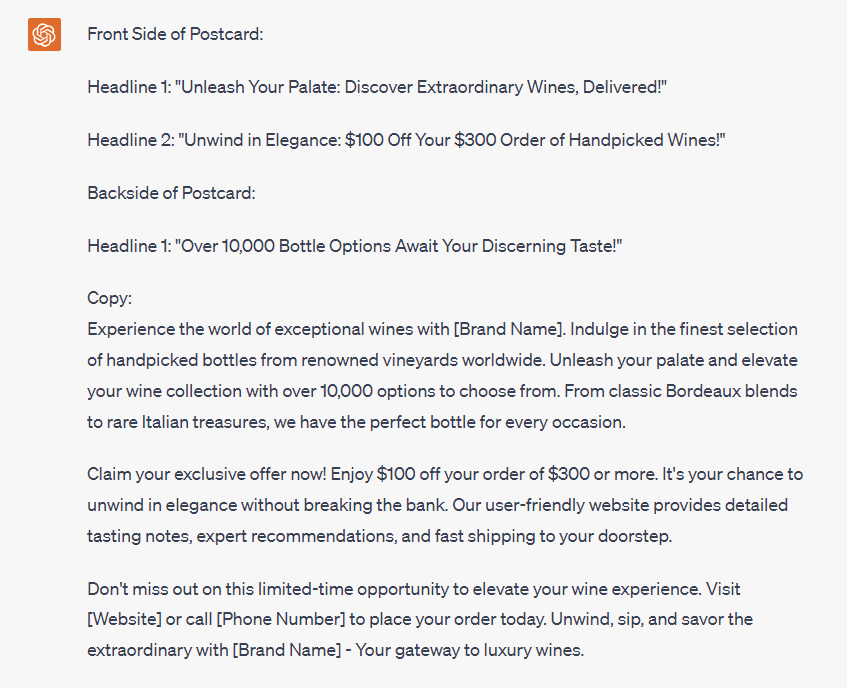
This prompt resulted in an improvement. However, it’s still quite wordy.
One of the best ways to maximize your direct mail postcard is to leverage bullet points and icons to emphasize important content while making your piece easily scannable. (This will be demonstrated in our designs later on).
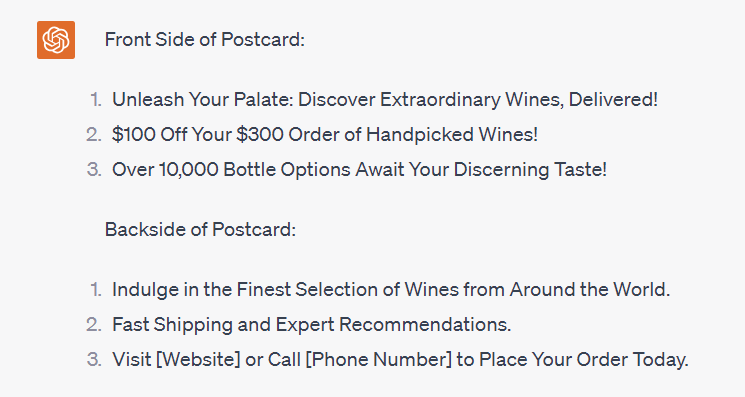
Now we have shorter, more concise copy. To get even more specific, we prompted ChatGPT to recommend imagery and copy placement.
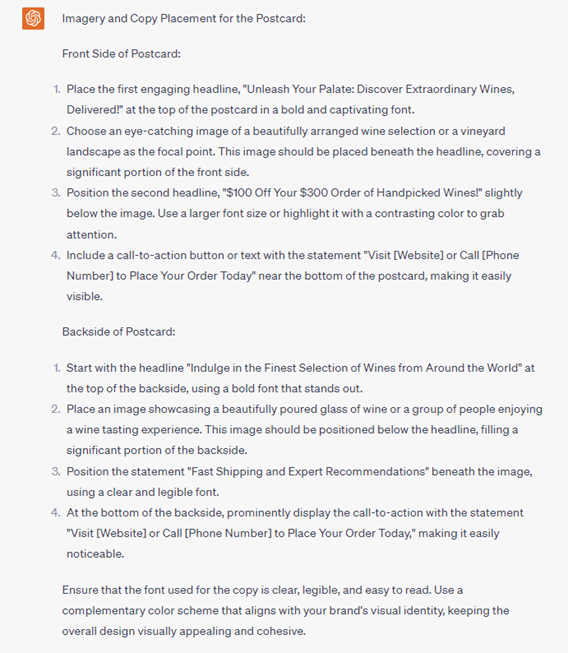
And we’ve struck gold! At this point, we felt confident to end the conversation and move forward with the experiment.
After five prompts, ChatGPT provided enough detail to aid in crafting a direct mail postcard. The tool recommended headers, body copy, and where to place content and imagery. With these instructions we designed a postcard. Here is the result:
 |  |
This entire ChatGPT prompting session and design process took less than 30 minutes. We can confidently say that ChatGPT is fully capable of “designing” a direct mail postcard from start to finish. This was a quick and inexpensive way to perform the normal duties of a designer and copywriter, mimicking a process that would otherwise require significantly more time and money, especially when working with freelance talent.
But is that enough? Does the execution match the level of what an experienced copywriter and designer create?
“Optimizing performance depends on pulling from the history of results as they relate to the specific client and industry. Their audience may respond better to something such as featuring their app, whereas another company in the same industry may not have a strong app worth promoting,” says Johnson. “In this case, highlighting it could have the opposite effect, underscoring the need for human collaboration.”
Below you will find the brand’s final postcard, which our creative team designed with direct response best practices, purpose, and experience leading every decision:
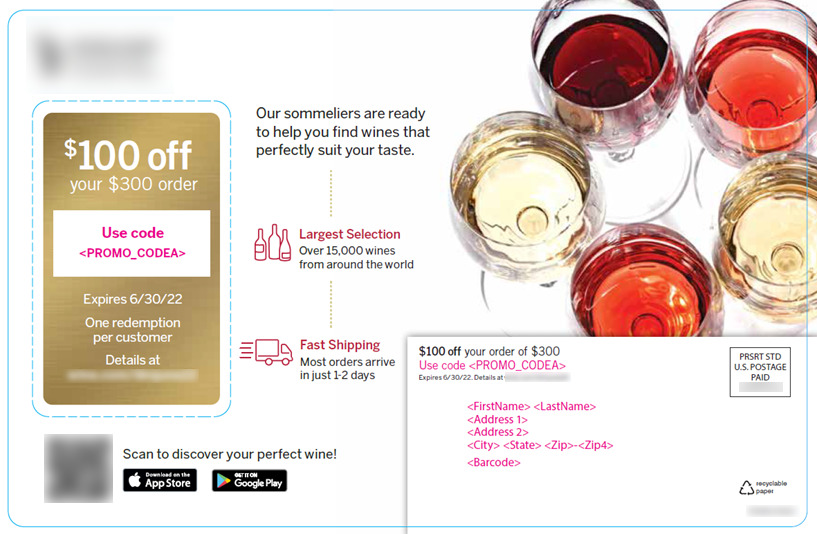 | 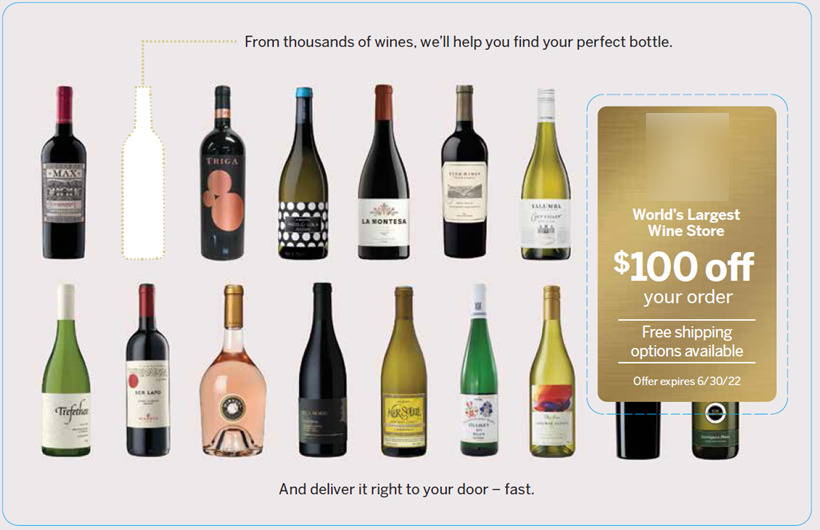 |
Based on prior testing and conversations with the client, we learned that showing a variety of wines outside of lifestyle photography, a perforated offer card, and messaging surrounding the variety of offerings perform best for this client.
With a full understanding of the brand’s guidelines and mission, as well as competitor research, the creative director, writer, and designer collaborated on the best way to bring this to life in an engaging way. The result was to showcase the variety along with a blank bottle to connect the prospect to the piece, letting them know they will find their perfect bottle among the vast selection available.
The creative process, including research, took roughly 10 hours, but the result captures the polish, creativity, and heart that are proven repeatedly to help the prospect feel connected and respond, which the ChatGPT version lacks.
Many brands and marketing agencies leverage AI tools to make decisions quickly and efficiently for their campaigns. It has many benefits, and this test proves its ability to assist with a plethora of tasks. The benefits of using ChatGPT for direct response copywriting include:
While a useful tool, ChatGPT has several limitations worth acknowledging. It may lend a helping hand, but the copy it outputs still needs to be touched by professionals. Here are a few limitations:

So, will AI replace copywriters? This test confirmed what we already know: tools like ChatGPT can support the creative process—but they can’t replace it. Effective direct response copywriting requires more than keywords or clever phrasing. It takes context, emotional intelligence, and the kind of intuition that only comes from real conversations, campaign experience, and strategic collaboration.
Connect with an FM Direct strategist today. Whether you’re exploring AI-enhanced creative or building a high-performance direct mail program from the ground up, we’re here to help. Download our free direct mail e-book or explore more insights into modern direct response marketing on our blog.